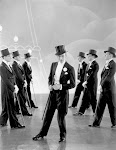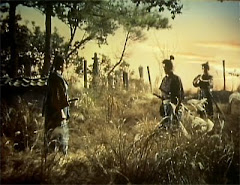 I've written a tribute piece on the man over at Ed Copeland on Films. Also, for the inclined, Mark Steyn has what looks to be one of several Ian Fleming pieces up, where he makes a similar point regarding the Bond formula.
I've written a tribute piece on the man over at Ed Copeland on Films. Also, for the inclined, Mark Steyn has what looks to be one of several Ian Fleming pieces up, where he makes a similar point regarding the Bond formula.
Wednesday, May 28, 2008
Ian Fleming - 100 Years
 I've written a tribute piece on the man over at Ed Copeland on Films. Also, for the inclined, Mark Steyn has what looks to be one of several Ian Fleming pieces up, where he makes a similar point regarding the Bond formula.
I've written a tribute piece on the man over at Ed Copeland on Films. Also, for the inclined, Mark Steyn has what looks to be one of several Ian Fleming pieces up, where he makes a similar point regarding the Bond formula.
Friday, May 16, 2008
The Mikasa
 Far from just being the pride and joy of a dynamic, if recent, Japanese naval history, the Mikasa is, sadly, the only ship that has survived Japan's imperial past to be preserved today as a museum in Yokosuka, near the U.S. Naval station. The Mikasa's glory long preceded the Pacific War, going back to Japan's debut as a top tier naval power during the Russo-Japanese War. During that time, she was the flagship of the Japanese Navy's combined fleet and led the charge to one of the most lop-sided naval victories in history, the Battle of Tsushima (1905).
Far from just being the pride and joy of a dynamic, if recent, Japanese naval history, the Mikasa is, sadly, the only ship that has survived Japan's imperial past to be preserved today as a museum in Yokosuka, near the U.S. Naval station. The Mikasa's glory long preceded the Pacific War, going back to Japan's debut as a top tier naval power during the Russo-Japanese War. During that time, she was the flagship of the Japanese Navy's combined fleet and led the charge to one of the most lop-sided naval victories in history, the Battle of Tsushima (1905). The Japanese, headed by the Mikasa, sank 35 of Russia's 38 ships while losing 3 torpedo boats. The victory was the result of having first class vessels and superior discipline. Japan and England were, at that time, closely allied against Russian expansionism. The command structure of the Japanese Navy was fashioned on the Royal Navy model. Comparatively, the Russian force, though greater in numbers, was comprised of ill trained landlubbing conscripts. Russia's Baltic Fleet showed tremendous stamina in trekking 18,000 miles to intercept the blockading Japanese fleet to free the Far East Fleet trapped in Port Arthur, but that was the extent of Russian naval prowess. The Russian defeat, combined with the 1905 revolution that almost toppled the czar, caused a rash of naval mutinies (the most famous being on the Battleship Potemkin). Despite the war being a total disaster for them, the Russians nevertheless managed to bloody the Japanese on land enough to allow Teddy Roosevelt to mediate a peace settlement. Meanwhile, the Japanese ended up gaining world-wide recognition for their military forces (particularly the navy) despite being exhausted by the war.
The Japanese, headed by the Mikasa, sank 35 of Russia's 38 ships while losing 3 torpedo boats. The victory was the result of having first class vessels and superior discipline. Japan and England were, at that time, closely allied against Russian expansionism. The command structure of the Japanese Navy was fashioned on the Royal Navy model. Comparatively, the Russian force, though greater in numbers, was comprised of ill trained landlubbing conscripts. Russia's Baltic Fleet showed tremendous stamina in trekking 18,000 miles to intercept the blockading Japanese fleet to free the Far East Fleet trapped in Port Arthur, but that was the extent of Russian naval prowess. The Russian defeat, combined with the 1905 revolution that almost toppled the czar, caused a rash of naval mutinies (the most famous being on the Battleship Potemkin). Despite the war being a total disaster for them, the Russians nevertheless managed to bloody the Japanese on land enough to allow Teddy Roosevelt to mediate a peace settlement. Meanwhile, the Japanese ended up gaining world-wide recognition for their military forces (particularly the navy) despite being exhausted by the war.  Work on the Mikasa started in 1899 and was finished in 1902 by Vickers Co., a British shipyard. Her design preceded the larger dreadnoughts, but can be seen as part of that same move to larger, more heavily armed vessels. During the Battle of the Yellow Sea (August of 1904), the Mikasa withstood 20 hits and was fully operational within a few days. During the Battle of Tsushima, she withstood 30 hits without sinking. Shortly after the Battle of Tsushima, while harboured in Sasebo, the Mikasa did sink after her magazine exploded. She was raised and repaired and returned to service, though her position as a flagship was shortlived with the introduction of larger more powerful vessels. The Mikasa survived the scrapheap after the Washington Naval Conference of 1922 under the stipulation that she would be a memorial ship. During WWII, the Mikasa was routinely bombed by the USAAF as she sat in Yokosuka (not sure if she was in the same spot as she is now). After the war, the Mikasa was stripped down and remained in disrepair until, with the backing of Admiral Nimitz, she was resurrected into the museum ship she is today. A good portion of the ship that is open to the public is preserved, more or less, as she was while in service. However, much of the ship is not open. The lower decks and the engine rooms are a mystery. What is open has been largely converted into exhibit rooms. There is even an auditorium showing an abbreviated (15 minute) version of Battle Anthem - a Japanese historical retelling of the Battle of Tsushima.
Work on the Mikasa started in 1899 and was finished in 1902 by Vickers Co., a British shipyard. Her design preceded the larger dreadnoughts, but can be seen as part of that same move to larger, more heavily armed vessels. During the Battle of the Yellow Sea (August of 1904), the Mikasa withstood 20 hits and was fully operational within a few days. During the Battle of Tsushima, she withstood 30 hits without sinking. Shortly after the Battle of Tsushima, while harboured in Sasebo, the Mikasa did sink after her magazine exploded. She was raised and repaired and returned to service, though her position as a flagship was shortlived with the introduction of larger more powerful vessels. The Mikasa survived the scrapheap after the Washington Naval Conference of 1922 under the stipulation that she would be a memorial ship. During WWII, the Mikasa was routinely bombed by the USAAF as she sat in Yokosuka (not sure if she was in the same spot as she is now). After the war, the Mikasa was stripped down and remained in disrepair until, with the backing of Admiral Nimitz, she was resurrected into the museum ship she is today. A good portion of the ship that is open to the public is preserved, more or less, as she was while in service. However, much of the ship is not open. The lower decks and the engine rooms are a mystery. What is open has been largely converted into exhibit rooms. There is even an auditorium showing an abbreviated (15 minute) version of Battle Anthem - a Japanese historical retelling of the Battle of Tsushima.

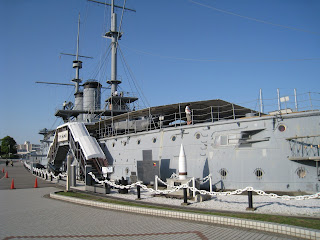


















Sunday, May 11, 2008
The John Lennon Museum, Saitama
 When we arrived to the museum very near the Saitama's Super Arena, there was a sea of Japanese teenage girls - thousands of them - waiting to enjoy a concert from S. Korea's hottest boy bands, TVXQ (Tohoshinki in Japan). Sadly, the picture above is of the museum as we were leaving (when the show was already in progress). It was a curious juxtaposition between a pop icon from 40 years ago to a spectacularly popular boy band in Asia that I'd never heard of. I wandered how many of these teenage girls would shriek in tears when Joongie showed his muscles?
When we arrived to the museum very near the Saitama's Super Arena, there was a sea of Japanese teenage girls - thousands of them - waiting to enjoy a concert from S. Korea's hottest boy bands, TVXQ (Tohoshinki in Japan). Sadly, the picture above is of the museum as we were leaving (when the show was already in progress). It was a curious juxtaposition between a pop icon from 40 years ago to a spectacularly popular boy band in Asia that I'd never heard of. I wandered how many of these teenage girls would shriek in tears when Joongie showed his muscles?John and Yoko spent time around the Saitama area when they were in Japan and in 2000, Yoko established the John Lennon Museum and adulation center there. It is a nice modest museum located very near the station and can be fully appreciated in about two hours.
 Despite many many worldview differences and the fact that I find may of Lennon's lyrics (mostly latter solo stuff) totally wrongheaded and occasionally reprehensible, he is still my favorite Beatle...on Tuesdays and Wednesdays. I'm a fan, but I never paid too much attention to his personal life beyond the main points. The museum provides a pretty basic depiction of his life and career that may be redundant for true aficionados, but was informative for me. I learned several things about the man (and the woman) that I had not known before, though nothing that changed my overall impressions. As a die-hard Dylan fan, I did note there was only one brief mention of Bob (a cliche reference to him as a protest singer) and no mention at all of him in describing John's transition from pop star to "serious" artist, which was a central theme of the museum. An even more noticeable omission was any narrative regarding his first wife, beyond a cursory mention. Nevertheless, the exhibits touched on most of the significant stuff - particularly where it concerned Yoko and John's deliverance from unhappiness.
Despite many many worldview differences and the fact that I find may of Lennon's lyrics (mostly latter solo stuff) totally wrongheaded and occasionally reprehensible, he is still my favorite Beatle...on Tuesdays and Wednesdays. I'm a fan, but I never paid too much attention to his personal life beyond the main points. The museum provides a pretty basic depiction of his life and career that may be redundant for true aficionados, but was informative for me. I learned several things about the man (and the woman) that I had not known before, though nothing that changed my overall impressions. As a die-hard Dylan fan, I did note there was only one brief mention of Bob (a cliche reference to him as a protest singer) and no mention at all of him in describing John's transition from pop star to "serious" artist, which was a central theme of the museum. An even more noticeable omission was any narrative regarding his first wife, beyond a cursory mention. Nevertheless, the exhibits touched on most of the significant stuff - particularly where it concerned Yoko and John's deliverance from unhappiness.The early period, too, was well represented with school aged notebooks and his first instruments lovingly preserved behind glass. I noticed that his handwriting was much nicer as a lad than it was as a Beatle (something I imagine was by design). His artwork, too, was a little more interesting to me when he was a boy, like the shot below, than his later minimalist scribblings that graced his books.
 I had never realized that, despite coming from a broken home and raised mainly by his aunt Mimi, John grew up in a nice comfortable and spacious home that his fellow Beatles did not enjoy. This combination seemed to make John the least-happy and most self-centered Beatle.
I had never realized that, despite coming from a broken home and raised mainly by his aunt Mimi, John grew up in a nice comfortable and spacious home that his fellow Beatles did not enjoy. This combination seemed to make John the least-happy and most self-centered Beatle.Several display cases covered the early pre-Please Please Me years of the Beatles. The most handsomely laid out display case is shown below. Heavy use of black leather and brown brick convey the atmosphere of the night club days.

Here's the two track recording machine used during the Sgt. Pepper sessions.

Here's a replication of sorts of the zany Yoko ceiling art that played a part with John and Yoko's initial meeting. One must climb the steps to get an insight into Yoko's genius.
 The genius, of course, was a plain word printed on the ceiling which made the trek up and down the staircase hardly seem worth the effort. Not only did I not fall in love with Yoko upon ascending the stairs, but I was a little resentful that she played me for a fool.
The genius, of course, was a plain word printed on the ceiling which made the trek up and down the staircase hardly seem worth the effort. Not only did I not fall in love with Yoko upon ascending the stairs, but I was a little resentful that she played me for a fool.  I must say, when thinking about Yoko, I'm always reminded of a joke Dave Foley said on the show Newsradio. Foley's character was trying to provide solace for one of the other characters, who considered herself a Yoko-type figure. He tried to defend that stigma by offering, with a studder (quoting from memory): "Well, there are those that think her work on Double Fantasy wasn't...completely...destructive." The stuttering made the joke. I've always thought she was a poor artist, but an interesting character. I can't say I understand what attracted Lennon to her, but I can kinda understand his later obsession with her. She is a weird and fascinating person - probably just as bizarre to the Japanese as she is to Americans like myself. And just when I think I might warm up to some of her antics, I see stuff like "Bagism" which makes me wonder what anyone sees in either of the two.
I must say, when thinking about Yoko, I'm always reminded of a joke Dave Foley said on the show Newsradio. Foley's character was trying to provide solace for one of the other characters, who considered herself a Yoko-type figure. He tried to defend that stigma by offering, with a studder (quoting from memory): "Well, there are those that think her work on Double Fantasy wasn't...completely...destructive." The stuttering made the joke. I've always thought she was a poor artist, but an interesting character. I can't say I understand what attracted Lennon to her, but I can kinda understand his later obsession with her. She is a weird and fascinating person - probably just as bizarre to the Japanese as she is to Americans like myself. And just when I think I might warm up to some of her antics, I see stuff like "Bagism" which makes me wonder what anyone sees in either of the two. It's impossible for me to separate the irreverent stupidity John often displayed with his irreverent cleverness. Bagism seems to be on the side of stupid. I've often tried to look into John's eyes, but can never get past the glasses.
It's impossible for me to separate the irreverent stupidity John often displayed with his irreverent cleverness. Bagism seems to be on the side of stupid. I've often tried to look into John's eyes, but can never get past the glasses. Here's the Primal Scream book that influenced John's first (and best) solo album. I haven't read the book, but I can't help but think that the way John sang earlier songs, like "Twist and Shout", he was achieving a similar cathartic release.
The "seal" of John's country. Ar! Ar!


Saturday, May 10, 2008
Nihon-ji Daibutsu, Nokogiri-yama
 The temple Kenkon-zan Nihon-ji on the Chiba peninsula off Tokyo Bay dates back to 725 A.D., but the daibutsu (large Buddha figure), itself, was chiseled in 1780. The temple has changed hands between various sects over those 1300 years and currently belongs to the Soto Zen sect. The main attractions of the temple grounds, in addition to the daibutsu, are three summit overlooks on Mt. Nokogori, which towers over the rocky coast of Tokyo Bay, 1500 smaller statues depicting various Arhats (novice practitioners who have achieved nirvana), a very tall relief of the Bodhisattva of Mercy, Kannon...and much more along the temple's immaculate trails. The following guide shows some of this:
The temple Kenkon-zan Nihon-ji on the Chiba peninsula off Tokyo Bay dates back to 725 A.D., but the daibutsu (large Buddha figure), itself, was chiseled in 1780. The temple has changed hands between various sects over those 1300 years and currently belongs to the Soto Zen sect. The main attractions of the temple grounds, in addition to the daibutsu, are three summit overlooks on Mt. Nokogori, which towers over the rocky coast of Tokyo Bay, 1500 smaller statues depicting various Arhats (novice practitioners who have achieved nirvana), a very tall relief of the Bodhisattva of Mercy, Kannon...and much more along the temple's immaculate trails. The following guide shows some of this:
View from the parking lot looking at the entrance to the temple grounds. This is about one third of the way up Mt. Nokogiri. The daibutsu is to the right of this shot.
 The daibutsu is 31 meters tall on its Lotus pedestal and is the largest in Japan, significantly taller than the daibutsu in Nara (18.8 meters) and over twice the height of the more famous Japanese daibutsu in Kamakura (13.3 meters). It has had its share of erosion over the years and received an overhaul in the 1960s. Still, you can see scars of the erosion all over its body. Keeping the erosion in check will no doubt be a challenge. There is a small moat running along the front edges of the stone statue.
The daibutsu is 31 meters tall on its Lotus pedestal and is the largest in Japan, significantly taller than the daibutsu in Nara (18.8 meters) and over twice the height of the more famous Japanese daibutsu in Kamakura (13.3 meters). It has had its share of erosion over the years and received an overhaul in the 1960s. Still, you can see scars of the erosion all over its body. Keeping the erosion in check will no doubt be a challenge. There is a small moat running along the front edges of the stone statue. The prayer bell and donation box in front of the statue attracted a steady stream of visitors while we were there and, assuming each prayer was accompanied with a 5 or 50 yen donation, the sect made out well on that day.
The prayer bell and donation box in front of the statue attracted a steady stream of visitors while we were there and, assuming each prayer was accompanied with a 5 or 50 yen donation, the sect made out well on that day.
The figure is Yakushi Nyorai, the Medicine Buddha or the Buddha of Healing. The Indian name for this buddha is Bhaiṣajyaguru, which is short for Bhaiṣajyaguruvaidūryaprabha. It was made by the popular artist Jingoro Eirei Ono and his 27 apprentices over the course of three years.

A profile shot of the daibutsu against the mountain. The trail of stairs is not visible in the picture but winds up steeply past the head of the statue just below the forest canopy. As with several of the photos in this post, the vertical nature of the mountain and its trails is not adequately displayed.

Here is the view from the daibutsu area overlooking Tokyo Bay.
 If you squint your eyes you can make out the small but sacred Bodhi Tree in the picture below. It comes from the branch of a famous Bodhi Tree in India and was presented to the temple by an Indian sect in 1989 as a gesture of world peace.
If you squint your eyes you can make out the small but sacred Bodhi Tree in the picture below. It comes from the branch of a famous Bodhi Tree in India and was presented to the temple by an Indian sect in 1989 as a gesture of world peace.
Another praying area with piles of little prayer statues.
 As with the prayer bell nearby, there was incense burning periodically.
As with the prayer bell nearby, there was incense burning periodically. The pathway that leads up to the top is scenic but brutal on the legs. It was a chilly and damp day, and yet, by the time I reached the top, I was pretty sweaty. The daibutsu is below and to the right of these steps.
The pathway that leads up to the top is scenic but brutal on the legs. It was a chilly and damp day, and yet, by the time I reached the top, I was pretty sweaty. The daibutsu is below and to the right of these steps. Along the way to the summit are numerous caves and inlets in the rock face which house 1500 Arhats all made by Ono and his 27 apprentices. Each statue is unique. Several of the statues have been worn down by erosion, or too often, defaced by an anti-Buddhist movement during the Meiji Era. Still, enough of these remain intact that I would imagine it would take some feverish radical Islamists several months to deface all of them.
Along the way to the summit are numerous caves and inlets in the rock face which house 1500 Arhats all made by Ono and his 27 apprentices. Each statue is unique. Several of the statues have been worn down by erosion, or too often, defaced by an anti-Buddhist movement during the Meiji Era. Still, enough of these remain intact that I would imagine it would take some feverish radical Islamists several months to deface all of them. The stones used for the statues were brought in from the Izu peninsula. Work on the statues began in 1779 and was finished by 1798.
The stones used for the statues were brought in from the Izu peninsula. Work on the statues began in 1779 and was finished by 1798.
 It was rainy on the day of our visit, which revealed how manicured the mountain is. Instead of simply keeping the pristine natural beauty of the mountain, the Japanese, having a hands-on approach to nature, provide impressive bridges and stone walkways along the path to add a human touch to the surroundings. Below, a small waterfall rains over one of the statues. In other parts of the trail you can see where drainage trenches were carved in the rock to control the flow. The overall result is very appealing to the eyes.
It was rainy on the day of our visit, which revealed how manicured the mountain is. Instead of simply keeping the pristine natural beauty of the mountain, the Japanese, having a hands-on approach to nature, provide impressive bridges and stone walkways along the path to add a human touch to the surroundings. Below, a small waterfall rains over one of the statues. In other parts of the trail you can see where drainage trenches were carved in the rock to control the flow. The overall result is very appealing to the eyes.

The cliff from the summit went straight down and was more dramatic than this photo indicates. The weather was overcast and hid much of the view in the photo.
 The name of Mt. Nokogiri derives from the word for "saw" and this picture of the section cut out of the mountain demonstrates why it has that name. Like the view from the summit, this photo does not capture how dramatic this view is. To the right of the people in the photo is the second of the large stone carvings on the mountain...
The name of Mt. Nokogiri derives from the word for "saw" and this picture of the section cut out of the mountain demonstrates why it has that name. Like the view from the summit, this photo does not capture how dramatic this view is. To the right of the people in the photo is the second of the large stone carvings on the mountain... Kannon, the Bodhisattva of Mercy. I'm not sure how old this particular carving is, but it is about 30 meters tall and pretty impressive in its almost interior looking surroundings. I expected to see Dr. Jones with a few local guides making their way to this spot.
Kannon, the Bodhisattva of Mercy. I'm not sure how old this particular carving is, but it is about 30 meters tall and pretty impressive in its almost interior looking surroundings. I expected to see Dr. Jones with a few local guides making their way to this spot. A section of bamboo off the trail during the descent.
A section of bamboo off the trail during the descent.

This shot shows some of the buildings on the temple grounds housing the priests. There were apparently several other buildings housing priests and monks, but those were not visible from the trail.
 This is a shot taken from the car showing the scene off the coastal road that leads to Mt. Nokogiri.
This is a shot taken from the car showing the scene off the coastal road that leads to Mt. Nokogiri.




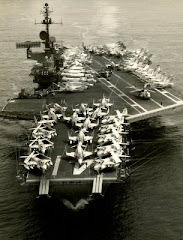
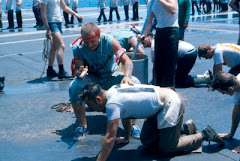



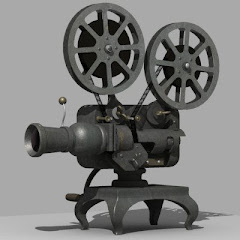
.jpg)
